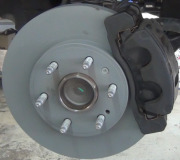There is no air gap between the pads and rotors. I never heard of anyone trying to measure that. There is a square-cut seal in each caliper that goes around the piston. When you apply the brakes, that seal sticks to the piston as the piston moves out to apply the brakes. Because it is sticking to the piston, it bends or deforms a little. When you release the brakes, that seal tries to straighten out. In doing so, that is what retracts the piston very slightly to prevent the pads from dragging. The amount the piston retracts is compared to the thickness of a sheet of paper.
There are two things that jumped out from your comments. The first one is in your very first sentence. You opened the bleeder screws at the calipers and the brakes didn't release. You are done at that point. We are trying to find where the pressurized brake fluid is being trapped and prevented from returning to the reservoir. No matter where that is occurring, opening the bleeder screws would release the fluid pressure and the brakes would release. Since that did not happen, there is no point in going to the master cylinder or its steel lines. There is no pressurized fluid trapped there once the bleeder screws were opened.
That quick test tells us you have a mechanical problem with the calipers, and you verified that when you found the pitted mounting bolts. Do not bother trying to clean them up. Replace them and be sure to lubricate them with high-temperature brake grease. Cleaning those bolts will not solve the problem. The caliper has to be able to slide on those bolts to self-adjust, to apply smoothly, and to release properly. Even if you can slide the caliper in and out by hand, there is tremendous force put on the caliper against those bolts when the spinning rotor tugs on the pads and caliper. With that force applied, the caliper will never slide freely. Once the chrome plating has lifted on those bolts, it is going to become embedded inside the rubber sleeves those bolts go through, so those must also be replaced. They are available as a hardware kit, and they come with rebuilt calipers.
The next thing to look at is the pistons. Very often a ring of dirt or rust builds up around it. You have new rotors and new pads. Both of those are a lot thicker than the old p[arts you took off, so you had to push the piston back into the caliper housing to make room for them. That forces that ring of dirt to go under the square-cut seal, and that will cause that caliper to not apply under light braking, and to not release after normal-to-hard braking. Back in the 1980's we rebuilt calipers as a part of every standard brake job, specifically to address this issue. Today we do not do that because we put miles on faster and go through more brake jobs before that dirt or rust has time to form. When we do need to take care of that, it is much less expensive now to just pop on a pair of professionally-rebuilt calipers. They used to cost around $95.00 each. Today they cost around $20.00 to $30.00 each. If you rebuild the calipers yourself, a ring of dirt on the pistons can be washed off with Brake Parts Cleaner and a rag, then inspect them for signs of lifted chrome plating and rust spots. If you see that, the piston must be replaced. In the 1980's they cost about $20.00. You are better off today just buying the rebuilt calipers.
To identify a sticking piston, use a medium flat-blade screwdriver to pry it back into the housing before you unbolt the caliper. It should slide in fairly easily, then you will have room for those new pads and rotor. If you ever resort to using a c-clamp or you need one to get the piston to retract, you are done. Replace the caliper or rebuild it. Needing a c-clamp means you are pushing the ring of rust or dirt under the square-cut seal, and you are going to have problems. Also, a lot of vehicles use phenolic pistons to reduce weight. Those are easy to crack with a c-clamp. Brake system specialists do not even have a c-clamp in their tool box. Think of it this way. If you need a c-clamp to make the piston move, and flimsy little rubber seal around it is definitely not going to retract it after braking.
Replace the caliper mounting bolts. Be sure to lubricate them. You should have used brake grease on the backs of the pads too and on the three "lands" each rear shoe slides on. Check the pistons. If they are free, you can often retract them with your hands. That is how we put them in when we rebuild the calipers. And be sure to put the power booster push rod back were it was. There is only one correct setting. It is not meant to be an adjustment that makes up for something else.
Friday, November 27th, 2020 AT 8:55 AM
(Merged)














